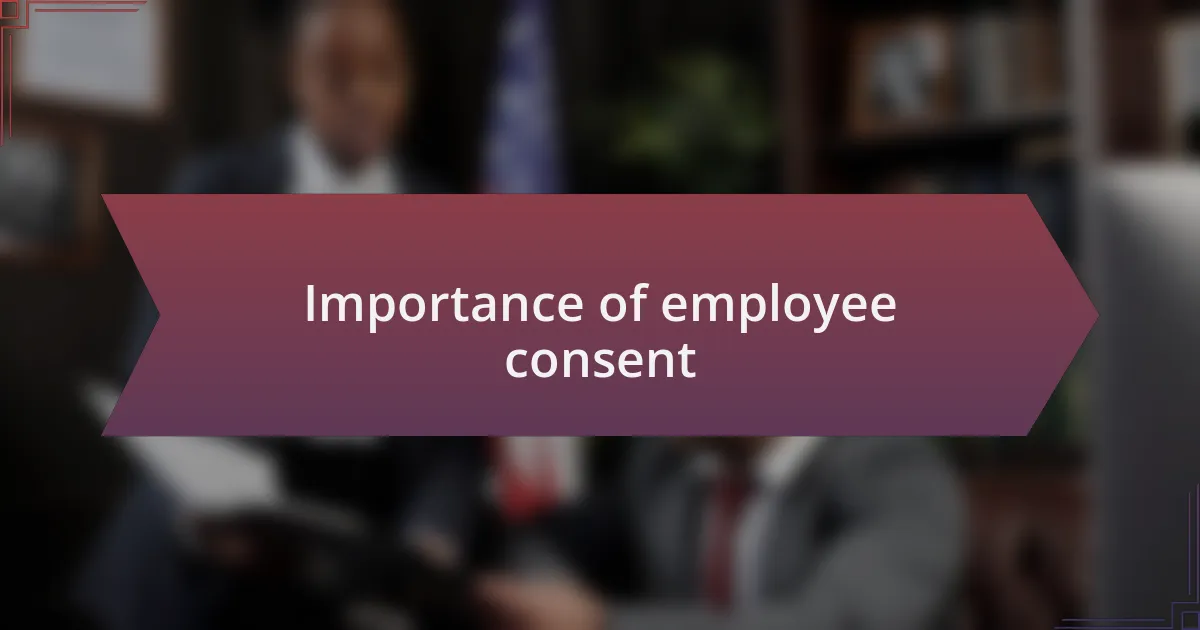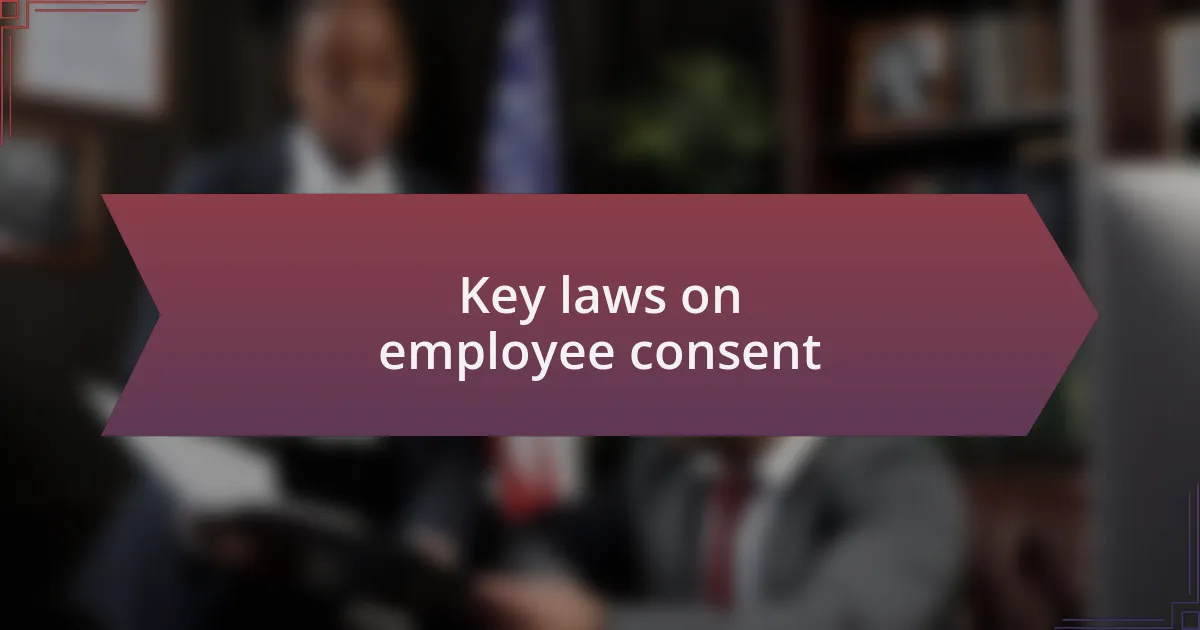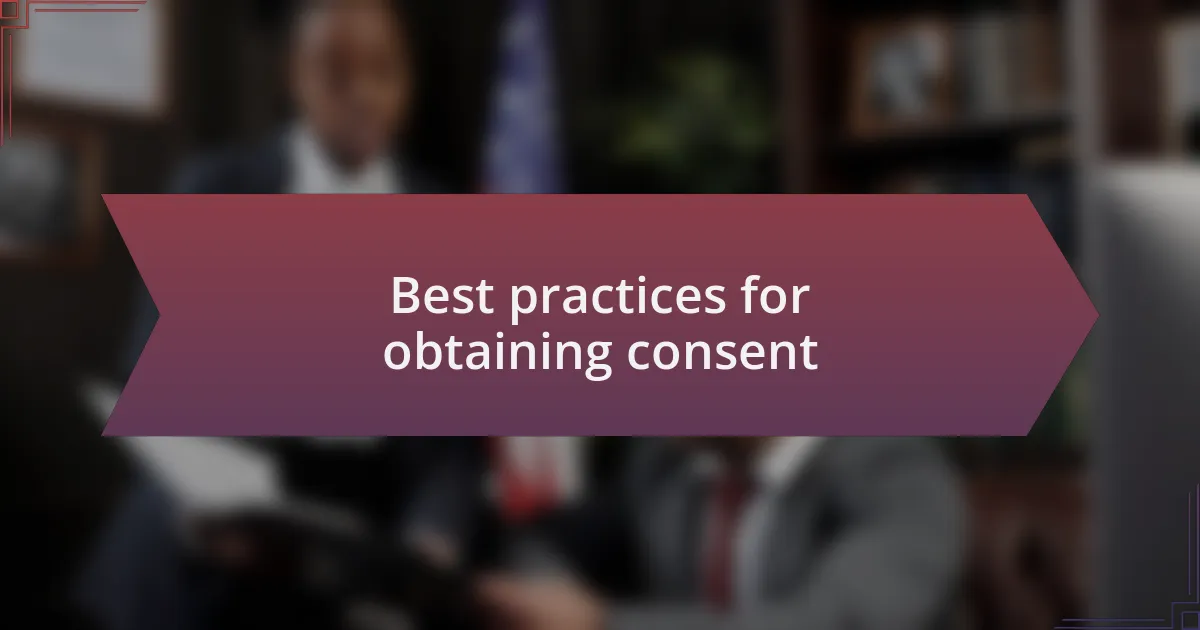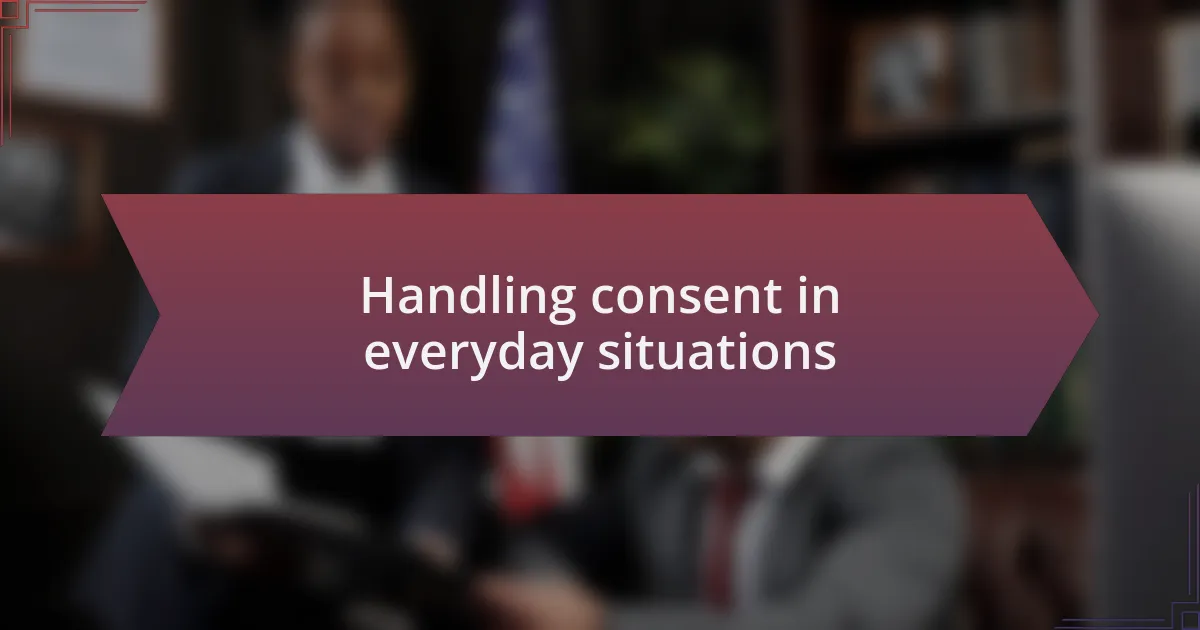Key takeaways:
- Employee consent should be based on genuine understanding and trust, not just formalities or obligations.
- Clear communication and transparency are critical for obtaining informed consent, especially regarding data protection laws like GDPR and CCPA.
- Consent should be treated as an ongoing conversation, requiring continued engagement and an open dialogue in the workplace.
- Effective communication involves active listening and using simple language to ensure all employees feel heard and understood.

Understanding employee consent
When I think about employee consent, it’s clear that it’s not just a checkbox to tick off. It’s about fostering a culture of trust and respect. For instance, I’ve worked in environments where employees felt uneasy about sharing their opinions because they weren’t confident their voices mattered. Isn’t it crucial to ensure that consent is genuinely informed and enthusiastic rather than simply assumed?
Understanding employee consent also means recognizing the nuances of communication. There’s a significant difference between someone agreeing because they feel obligated versus feeling empowered to say yes. I recall a situation where I actively sought feedback from team members about changes in our policy. The conversations that followed were so enlightening, revealing how important the feeling of being genuinely heard is to employees.
Consider the implications of obtaining consent in relation to data protection, especially in today’s digital age. It’s not just about having a signature on a form; it’s about ensuring that employees understand what they’re consenting to. Reflecting on my own experiences, I’ve seen how transparency in these processes can lead to stronger, more trusting relationships. Were these conversations easy? Not always, but they were absolutely essential.

Importance of employee consent
When I think about the importance of employee consent, I often reflect on my early days in management. I remember a project where I assumed team members were on board. However, a lack of explicit consent led to disengagement and resentment. This experience taught me that obtaining genuine consent can transform collaboration and lead to more effective teamwork.
Moreover, the emotional investment of employees is directly tied to how their consent is handled. I’ve witnessed firsthand how acknowledging an employee’s right to choose can elevate their commitment to their work. It’s fascinating how when individuals feel respected and included in decision-making, they not only consent but also become enthusiastic advocates for their organization. What if we recognized every agreement as an opportunity to build a stronger workplace culture?
Another critical aspect is the legal implications of consent. With compliance and regulatory standards evolving, I’ve seen companies risk significant penalties due to oversights in the consent process. In my experience, being proactive about seeking and recording consent not only mitigates risk but also reinforces the message that employees’ voices are valued. How can we afford to overlook such an essential element in the workplace?

Key laws on employee consent
When discussing key laws on employee consent, one of the most critical regulations to consider is the General Data Protection Regulation (GDPR). I remember a time when a client faced an investigation because they were not properly obtaining consent for employee data processing. This law emphasizes that consent must be informed, specific, and revocable. It taught me that merely assuming consent isn’t sufficient; clear communication is essential.
Moreover, employment laws vary by region, but foundational principles like the California Consumer Privacy Act (CCPA) underscore the importance of written consent, especially when handling personal data. I once worked with a company making a major move into California, and the team learned quickly that compliance was not just about ticking boxes but about truly respecting employee privacy. Are we truly aware of the hoops we need to jump through to uphold these laws and safeguard our teams?
In addition to data protection laws, labor regulations often intersect with consent practices, particularly regarding workplace policies and practices. I recall creating an employee handbook that required clear acknowledgment of policies by each team member. It was eye-opening to see how often employees didn’t read the fine print. How do we handle situations where employees don’t fully understand what they’re consenting to? This realization highlights the ongoing need for transparency and dialogue, ensuring that consent is not just a formality but a mutual understanding.

Best practices for obtaining consent
When obtaining consent, it’s essential to create an environment where employees feel comfortable asking questions. I remember a time when I held a workshop to explain our new data collection practices. It was incredible to see employees expressing their apprehensions and seeking clarification. This experience underscored to me that providing a space for open dialogue is just as vital as the consent form itself—it fosters trust and ensures compliance.
Using plain language in consent documents is another best practice I’ve found crucial. In one instance, I revised a technical consent form that had baffled many employees. After simplifying the language, I noticed a marked decrease in confusion and an increase in signed acknowledgments. Isn’t it our responsibility to ensure everyone understands what they’re consenting to?
Lastly, I’ve learned that consent should be an ongoing conversation, not a one-time checkbox. A colleague once shared how they followed up with team members months after obtaining consent to revisit any lingering questions or concerns. This approach not only reinforced understanding but also demonstrated genuine commitment to employee rights. What strategies are we employing to make consent an ongoing part of our workplace culture?

Handling consent in everyday situations
In the hustle and bustle of everyday work life, handling consent can often feel like just another task on an endless checklist. However, I remember a particularly busy afternoon when I had to ask my team for consent for a new performance review system. Instead of just sending out the consent forms, I took a few minutes to sit down with each person individually. Their expressions shifted from skepticism to appreciation as they realized I genuinely cared about their thoughts and concerns. This experience taught me that taking the extra time to engage personally can transform a routine process into a meaningful exchange.
I’ve also found that leveraging informal settings can help ease the consent conversation. During a coffee break, I once casually brought up the topic of our new privacy policy changes with a small group of colleagues. The relaxed ambiance led to a lively discussion where everyone felt free to share their opinions. I was surprised by how many questions surfaced, and some even proposed ideas for improvement. This made me realize that consent could blossom in organic, informal moments, making employees feel valued and heard.
Finally, there’s a delicate balance in ensuring consent aligns with the evolving needs of the workplace. A few months back, during a project update meeting, I paused to remind everyone that their consent regarding a project’s data handling was still important. I encouraged them to voice any doubts or adjustments based on their experiences so far. I found that creating an atmosphere of ongoing consent—where employees can feel empowered to change their minds—fosters a culture of respect and collaboration. How could we further support our teams in embracing this dynamic approach to consent?

Tips for effective communication
One of the most effective communication tips I’ve learned is the power of active listening. I recall a time when a colleague hesitated to provide feedback on a recent initiative. Instead of rushing to explain the rationale behind our decisions, I invited her to share her thoughts first. As she spoke, I made a conscious effort to nod and reflect her feelings back to her, which helped build a bridge of trust. I realized then that when employees feel truly heard, they are more likely to share their consent or concerns openly.
Being transparent about the purpose behind seeking consent also plays a crucial role in effective communication. When rolling out a new initiative, I made it a point to explain why I needed my team’s input. For instance, I shared how their feedback would not only shape the outcome but also reflect their values as a group. I remember the moment I saw their engagement spike; once they understood the ‘why,’ their willingness to provide consent surged. It left me wondering—how can leaders better articulate their intentions to foster more open dialogue?
Moreover, using simple, relatable language helps ensure that everyone is on the same page. In one meeting, I noticed some team members seemed lost when jargon was thrown around. Instead of pushing through, I paused and asked if anyone needed clarification. This approach turned the conversation into a collaborative effort rather than a lecture. I’ve come to appreciate that effective communication isn’t just about conveying information; it’s about making sure the message resonates with all. How have your communication strategies evolved in your workplace?